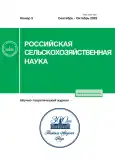Моделирование режимов возникновения "солевой каймы" при капельном орошении
- Авторы: Дубенок Н.Н1, Новиков А.Е2,3, Алексеев В.В4, Васильев С.А4, Филиппов В.П4, Михеев П.А1
-
Учреждения:
- Российский государственный аграрный университет - МСХА имени К. А. Тимирязева
- Всероссийский научно-исследовательский институт орошаемого земледелия
- Волгоградский государственный технический университет
- Чувашский государственный университет имени И. Н. Ульянова
- Выпуск: № 5 (2023)
- Страницы: 49-53
- Раздел: Статьи
- URL: https://journals.rcsi.science/2500-2627/article/view/233874
- DOI: https://doi.org/10.31857/S2500262723050095
- EDN: https://elibrary.ru/PSJGKR
- ID: 233874
Цитировать
Полный текст
Аннотация
Об авторах
Н. Н Дубенок
Российский государственный аграрный университет - МСХА имени К. А. Тимирязева127550, Москва, ул. Тимирязевская, 49
А. Е Новиков
Всероссийский научно-исследовательский институт орошаемого земледелия;Волгоградский государственный технический университет400002, Волгоград, ул. им. Тимирязева, 9;400005, Волгоград, просп. им. В. И. Ленина, 28
В. В Алексеев
Чувашский государственный университет имени И. Н. Ульянова
Email: vsa_21@mail.ru
428015, Чебоксары, Московский просп. 15
С. А Васильев
Чувашский государственный университет имени И. Н. Ульянова428015, Чебоксары, Московский просп. 15
В. П Филиппов
Чувашский государственный университет имени И. Н. Ульянова428015, Чебоксары, Московский просп. 15
П. А Михеев
Российский государственный аграрный университет - МСХА имени К. А. Тимирязева127550, Москва, ул. Тимирязевская, 49
Список литературы
- Моделирование влияния удобрений на динамику контуров увлажнения при капельном орошении / И. А. Успенский, И. В. Фадеев, В. В. Алексеев и др. // Инженерные технологии и системы. 2021. Т. 31. № 1. С. 97-108. doi: 10.15507/2658-4123.031.202101.097-108.
- Водно-физические свой ства каштановых почв при разных способах обработки почвы / Н. Н. Дубенок, А. Е. Новиков, А. А. Поддубский и др. // Вестник Российского университета дружбы народов. Серия: Агрономия и животноводство. 2023. Т. 18. № 1. С. 45-58.
- Капиллярно-сорбционные эффекты в почве после чизелевания и внесения нетрадиционных удобрений-мелиорантов / В. И. Пындак, А. Е. Новиков, В. Н. Штепа и др. // Известия Нижневолжского агроуниверситетского комплекса: Наука и высшее профессиональ-ное образование. 2016. № 3 (43). С. 252-257.
- Юсупов М., Аминов С. М., Саидов У. М. Численное моделирование задачи солепереноса в почвогрунтах // Проблемы вычислительной и прикладной математики. 2020. № 1 (25). С. 85-93.
- Кравченко Е. И., Хитров Н. Б., Горохова И. Н. Распределение засолений орошаемые почвы в район Сарпинской ложбины Прикаспийский низменности // Бюллетень Почвенного института имени В. В. Докучаева. 2021. Вып. 106. С. 5-48. doi: 10.19047/0136-1694-2021-106-5-48.
- Properties of sod-podzolic soil in European Russia with drip irrigation of the fruit nursery / N. N. Dubenok, A. V. Gemonov, A. V. Lebedev et al. // IOP Conference Series: Earth and Environmental Science. 2022. 012108. URL: https://www.researchgate.net/publication/360034690_Properties_of_sod-podzolic_soil_in_European_Russia_with_drip_irrigation_of_the_fruit_nursery (дата обращения: 20.09.2023). doi: 10.1088/1755-1315/1010/1/012108.
- Кизяев Б. М., Максименко В. П., Губин В. К. Водо-сберегающие технологии промывки засоленных почв // Мелиорация и водное хозяйство. 2016. № 4. С. 38-43.
- Попова В. П., Фоменко Т. Г., Макарова А. А. Оценка влияния капельного орошения минерализованными водами на изменение свой ств чернозема обыкновенного и состояние насаждений яблони // Плодоводство и виноградарство Юга России. 2021. № 67 (1). С. 226-241. doi: 10.30679/2219-5335-2021-1-67-226-241.
- Цифровая фитоиндикация засоления почв в сухой степи (республика Калмыкия) / К. О. Прокопьева, М. В. Конюшкова, Н. М. Новикова и др. // Аридные экосистемы. 2021. Т. 27. № 2 (87). С. 68-81. doi: 10.24411/1993-3916-2021-10152.
- Кравченко Е. И., Хитров Н. Б., Горохова И. Н. Двумерное распределение засоления орошаемых почв рядом с оросительным каналом на участке "Червленое" Светлоярской оросительной системы // Бюллетень Почвенного института имени В. В. Докучаева. 2018. Вып. 94. С. 19-37. doi: 10.19047/0136-1694-2018-94-19-37.
- Влияние фертигации на засоление почвы / Б. Г. Зиганшин, И. Г. Галиев, Р. К. Хусаинов и др. // Вестник Казанского государственного аграрного университета. 2020. Т. 15. № 4 (60). С. 67-70.
- Modeling the transfer of potassium monophosphate with irrigation water in drip irrigation and sprinkling / V. Alekseev, R. Alexandrov, S. Vasiliev et al. //International Conference on Modern Trends in Manufacturing Technologies and Equipment: Mechanical Engineering and Materials Science.2020. 05010. URL: https://www.matec-conferences.org/articles/matecconf/pdf/2020/25/matecconf_icmtmte2020_0501.pdf (дата обращения: 20.09.2023). doi: 10.1051/matecconf/202032905010.
Дополнительные файлы









